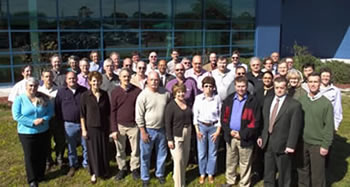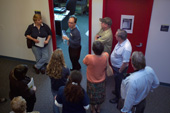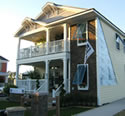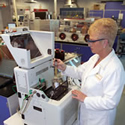| Issue No. 11: April 2007 |
TECHNICAL REPORT |
|
||||||||||||||||||||
|
FSEC IN THE NEWS
NEWS FROM AROUND THE WORLD
I want to share with you some comments I made to our Policy Advisory Board at their meeting at the Center on February 26. Philip Fairey and I put together a presentation on what needs to be done to secure an energy-efficient and environmentally safe future for Florida. I thought you would find these comments interesting.
The Walt Disney World Company's "Strive for Five" energy reduction program has been named the winner of the second annual Florida Energy Achievement Award which is presented by FSEC to a company, organization or individual that has made a significant achievement in the efficient utilization of energy, energy conservation, energy education or renewable energy in the state of Florida. For complete details on the award, visit www.fsec.ucf.edu/en/media/enews/2007/2007-03_EnergyAward.htm. FEATURE STORIES FSEC Provides Assistance to Homes Featured at International Builders' Show
Among the highlights of this year’s National Association of Home Builders’ International Building Show in Orlando in February were some high-performance homes that attracted a lot of attention for their energy-saving construction and features. The work of a number of center researchers helped with the design and planning of these homes as well as the information given to interested attendees. With more than 100,000 builders and others in the construction industry attending the show, FSEC’S efforts helped make these homes a big success.
New Hydrogen Lab Equipment Paves the Way for Expanded Research
One of the Center’s fastest-growing and most popular research programs is the hydrogen and fuel cell area, topics that are in the news often for their promise in providing power for both our transportation energy needs and for our homes and other buildings. A growing research program has enabled FSEC to buy some specialized new equipment that will assist researchers with better and quicker results.
Monitoring System Forms the Backbone of Research Projects You may have seen the recent technical report on the novel “NightCool” cooling concept assessment in scale test buildings written by Danny Parker and John Sherwin. It gives the results of an interesting research project carried out at FSEC which is demonstrating a 20 percent or greater reduction in space cooling loads than previously achievable with the very best existing building and equipment technologies. One thing that stands out is the rigor and precision of the research that allows for such detailed testing.
High School Science Bowl Held at FSEC in March Fourteen student teams from schools throughout the state participated in the 2007 Southeast Regional Science Bowl competition at FSEC on March 3. This year’s winners were: first place: Miami Palmetto Senior High School; second place: Brevard Schools Collaborative, and third place: Durant High School from Hillsborough County. Vacant Home Space Conditioning Strategies on Summer Relative
Humidity,
About 900,000 retiree "snowbirds" make Florida their winter destination to escape the northern cold. This pattern of seasonal occupancy creates a need for space conditioning guidelines for vacant homes to avoid mold problems while minimizing both customer energy usage and electrical load during utility peak hours. The Vacant Home Space Conditioning Study was sponsored by Florida Power & Light (FPL) as part of its Conservation R&D Program and carried out by FSEC beginning in 2004. Three homes in Brevard County were equipped with monitoring equipment for the experiments: a 45-year-old, 1,100-square-foot single-story, painted concrete block home on a concrete slab with a low pitch tar and gravel roof; a 40-year-old 1,950-square-foot split-level home with block and frame construction, and a 900-square-foot single-wide mobile home manufactured in 1984. All three test-homes had 2.5-ton central air conditioning (AC) systems with heat pump, gas, and electric strip heating, respectively. Five space conditioning strategies for vacant homes were assessed during hot, humid summer conditions and/or warm, humid fall weather conditions, to control relative humidity (RH), minimize energy use, and limit peak electrical demand:
An important observation was that some homes require more aggressive action to control RH than others. Air infiltration was found to be an important factor in the struggle against high indoor RH. Air infiltration, usually measured in air changes per hour, is the rate at which outside air enters the house. Homes that have higher infiltration rates require greater moisture removal rates to achieve RH control. Click here (2.2 MB PDF) to read the complete paper. |
|||||||||||||||||||||
This newsletter has been produced by Ken Sheinkopf, Sherri Shields and Dianne Wood. All photos were taken by Nick Waters, unless otherwise noted. |
|||||||||||||||||||||






